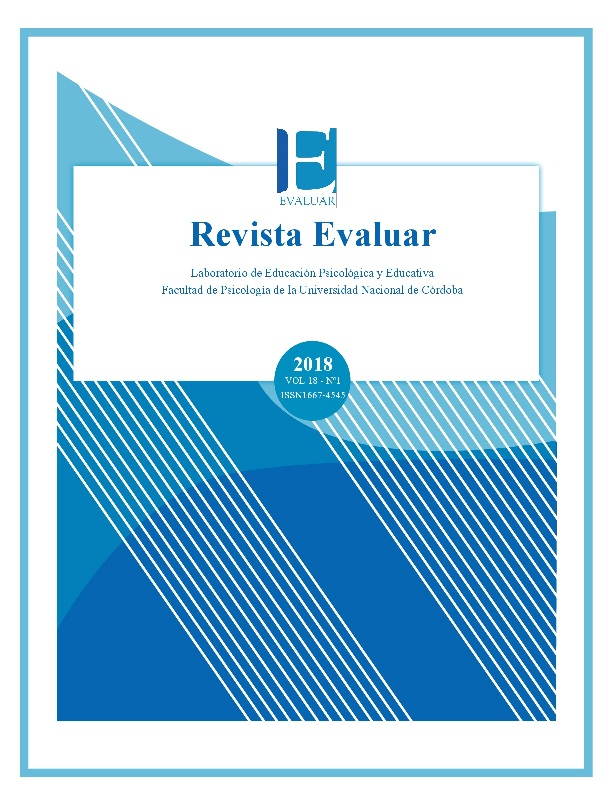Development and Validation of an Instrument for the Measurement of Religious Coping Strategies
DOI:
https://doi.org/10.35670/1667-4545.v18.n1.19771Keywords:
religious coping, coping, religiosity, psychometric properties, validationAbstract
This article examines the psychometric properties of the Religious Coping Strategies Inventory (IEAR) in a sample of Puerto Rican adults. Religious coping methods are ways of understanding and dealing with negative life events that are related to the sacred. A total of 350 Puerto Ricans participated in this exploratory and psychometric study. The results indicated that the scale has a two-factor structure. These factors were denominated internal strategies and external strategies. A total of 12 items complied with the criteria of discrimination and presented appropriate factorial loads (six items per factor). The reliability index of the scale was of .95 (Cronbach’s alpha). These results suggest that the IEAR has the potential to measure this construct among Puerto Rican adults. Likewise, the IEAR will advance further research of religious coping in Puerto Rico and Latin America.
Downloads
References
Ano, G. G., & Vasconcelles, E. B. (2005). Religious coping and psychological adjustment to stress: A meta-analysis. Journal of Clinical Psychology, 61(4), 461-480. doi: 10.1002/jclp.20049
Arbuckle, J. L. (2016). Amos (Versión 24.0) [software de cómputo]. Chicago, IL: IBM SPSS.
Asociación Americana de Psicología (2010). Diccionario conciso de Psicología. México: Manual Moderno.
Asociación Americana de Psiquiatría (2013). Manual diagnóstico y estadístico de los trastornos mentales: DSM-5. Washington, DC: Autor.
Bagozzi, R. P., & Yi, Y. (1988). On the evaluation of structural equation models. Journal of the Academy of Marketing Science, 16(1), 74-94. doi: 10.1007/BF02723327
Beck, J. (2011). Cognitive-Behavior Therapy. Basics and beyond. New York, NY: Guilford.Bonelli, R. M., & Koenig, H. G. (2013). Mental disorders, religion and spirituality 1990 to 2010: A systematic evidence-based review. Journal of Religion and Health, 52(2), 657-673. doi: 10.1007/s10943-013-9691-4
Byrne, B. M. (2010). Structural equation modeling with AMOS: Basic concepts, applications, and programming. New York: Psychology Press.
Carver, C. S., Scheier, M. F., & Weintraub, J. K. (1989). Assessing coping strategies: A theoretically based approach. Journal of Personality and Social Psychology, 56(2), 267-283. doi: 10.1037/0022-3514.56.2.267
Colón-Rivera, Y. (2014). Traducción, adaptación cultural y validación del Brief Religious Coping Scale en una muestra de puertorriqueños/as. (Disertación doctoral). Ponce Health Sciences University, Ponce, Puerto Rico.
Endler, N. S., & Parker, J. D. (1999). Coping Inventory for Stressful Situations (CISS): Manual. Toronto, ON, Canadá: Multi-Health Systems.
Folkman, S., & Lazarus, R. S. (1980). An analysis of coping in a middle-aged community sample. Journal of Health and Social Behavior, 21(3), 219-239. doi: 10.2307/2136617
Folkman, S., & Lazarus, R. S. (1988). Manual for the Ways of Coping Questionnaire. Palo Alto, California: Consulting Psychologists Press.
Fornell, C., & Larcker, D. F. (1981). Evaluating structural equation models with unobservable variables and measurement error. Journal of Marketing Research, 18(1), 39-50. Recuperado de http://www.jstor.org/stable/3151312
González-Rivera, J. A. (2015). Espiritualidad en la clínica: Integrando la espiritualidad en la psicoterapia y la consejería. San Juan, PR: Ediciones Psicoespiritualidad.
González-Rivera, J. A. (2017). Propiedades psicométricas de la Escala de Religiosidad Personal en una muestra de adultos en Puerto Rico. Revista Electrónica de Psicología Iztacala, 20(4), 1386-1406. Recuperado de http://www.iztacala.unam.mx/carreras/psicologia/psiclin/principal.html
González-Rivera, J. A., Veray-Alicea, J., & Rosario-Rodríguez, A. (2016). Actitudes hacia la integración de la espiritualidad en las profesiones de ayuda: Estudio exploratorio. Revista Griot, 9(1), 57-67. Recuperado de http://revistas.upr.edu/index.php/grio t/
Green, M., & Elliott, M. (2010). Religion, health and psychological well-being. Journal of Religion and Health, 49(2), 149-163. doi: 10.1007/s10943-009-9242-1
IBM Corp (2016). IBM SPSS Statistics for Windows, Version 24.0. [software de cómputo]. Armonk, NY: IBM Corp.
Kline, P. (2000). The Handbook of Psychometric Testing.New York: Routledge.Kline, T. J. (2005). Psychological testing: A practical approach to design and evaluation. Thousand Oaks: Sage. doi: 10.4135/9781483385693
Koenig, H. (2008). Medicine, religion and health: Where science and spirituality meet. West Conshohocken, PA: Temple Foundation Press. doi: 10.1097/01.nmd.0000349943.48219.f5
Koenig, H. G. (2012). Religion, spirituality, and health: The research and clinical implications. International Scholarly Research Network, 2012, 1-33. doi: 10.5402/2012/278730
Koenig, H. G. (2015). Religion, spirituality, and health: A review and update. Advances in Mind-Body Medicine, 29(3), 19-26. Recuperado de https://www.readbyqxmd.com/read/26026153/religion-spirituality-and-health-a-review-and-update
Lazarus, R. S., & Folkman, S. (1986). Estrés y procesos cognitivos. Barcelona: Martínez Roca.
MacCallum, R. C., Widaman, K. F., Preacher, K. J., & Hong, S. (2001). Sample size in factor analysis: The role of model error. Multivariate Behavioral Research, 36(4), 611-637. doi: 10.1207/S15327906MBR3604_06
Mezzadra, J., & Simkin, H. (2017). Validación de la escala abreviada de afrontamiento religioso Brief-RCOPE en el contexto argentino en estudiantes de confesión católica. Revista Evaluar, 17(1), 18-28. Recuperado de https://revistas.unc.edu.ar/index.php/revaluar
Montero, I., & León, O. G. (2007). A guide for naming research studies in psychology. International Journal of Clinical and Health Psychology, 7(3), 847-862. Recuperado de http://www.aepc.es/ijchp/GNEIP07_es.pdf
Pagán-Torres, O. M., Reyes-Estrada, M., & Cumba-Avilés, E. (2017). Religión, espiritualidad y terapia cognitivo conductual: Una reseña actualizada. Salud y Conducta Humana, 4(1), 13-34. Recuperado de http://rsych.com/
Panzini, R. G., & Bandeira, D. R. (2005). Escala de Coping Religioso-Espiritual (Escala CRE): Elaboração e validação de construto. Psicologia em Estudo, 10(3), 507-516. doi:10.1590/s1413-73722005000300019
Pargament, K. I. (1997). The psychology of religion and coping: Theory, research and practice. New York: The Guilford Press.
Pargament, K., Feuille, M., & Burdzy, D. (2011). The Brief RCOPE: Current psychometric status of a short measure of religious coping. Religions, 2(1), 51-76. doi: 10.3390/rel2010051
Pargament, K. I., Koenig, H. G., & Perez, L. (2000). The many methods of religious coping: Development and initial validation of the RCOPE. Journal of Clinical Psychology, 56(4), 519-543. doi: 10.1002/(SICI)1097-4679(200004)56:4<519::AID-JCLP6>3.0.CO;2-1
Pargament, K. I., Koenig, H. G., Tarakeshwar, N., Hahn, J. (2001). Religious struggle as a predictor of mortality among medically ill elderly patients: A two-year longitudinal study. Archives of Internal Medicine, 161(15), 1881-1885. doi: 10.1001/archinte.161.15.1881
Pargament, K. I., Smith, B. W., Koenig, H. G., & Perez, L. (1998). Patterns of positive and negative religious coping with major life stressors. Journal for the Scientific Study of Religion, 37(4), 710-724. Recuperado de http://www.jstor.org/stable/1388152
Pargament, K. I., & Raiya, H. A. (2007). A decade of research on the psychology of religion and coping: Things we assumed and lessons we learned. Psyche and Logos, 28(2), 742-766. Recuperado de https://tidsskrift.dk/psyke/article/viewFile/8398/6958
Pendleton, S. M., Cavalli, K. S., Pargament, K. I., & Nasr, S. Z. (2002). Religious/spiritual coping in childhood cystic fibrosis: A qualitative study. Pediatrics, 109(1), e8. doi: 10.1542/peds.109.1.e8
Pew Research Center’s Forum on Religion & Public Life (2012). The global religious landscape: A report on the size and distribution of the world’s major religious groups as of 2010. Recuperado de http://www.pewforum.org/2012/12/18/global-religious-landscape-exec/
Quiceno, J., & Vinaccia, S. (2011). Creencias-prácticas y afrontamiento espiritual-religioso y características sociodemográficas en enfermos crónicos. Psychologia, 5(1), 25-36. Recuperado de http://www.scielo.org.co/pdf/psych/v5n1/v5n1a03.pdf
Raykov, T., & Shrout, P. E. (2002). Reliability of scales with general structure: Point and interval estimation using a structural equation modeling approach. Structural Equation Modeling, 9(2), 195-212. doi: 10.1207/S15328007SEM0902_3
Reyes-Estrada, M., Rivera-Segarra, E., Ramos-Pibernus, A., Rosario-Hernández, E., & Rivera-Medina, C. (2014). Desarrollo y validación de una escala para medir religiosidad en una muestra de adultos en Puerto Rico. Revista Puertorriqueña de Psicología, 25(2), 226-242. Recuperado de http://www.redalyc.org/articulo.oa?id=233245622005
Richards, P. S., & Bergin, A. E. (2014). Handbook of psychotherapy and religious diversity (2ª ed.). Washington, DC, US: American Psychological Association. doi: 10.1037/14371-000
Rosenstiel, A. K., & Keefe, F. J. (1983). The use of coping strategies in chronic low back pain patients: Relationship to patient characteristics and current adjustment. Pain, 17(1), 33-44. doi: 10.1016/0304-3959(83)90125-2
Satorra, A., & Bentler, P. M. (2001). A scaled difference chi-square test statistic for moment structure analysis. Psychometrika, 66(4), 507-514. doi: 10.1007/BF02296192
Scharrón del Río, M. del R. (2010). Supuestos, explicaciones y sistemas de creencias: Ciencia, religión y psicología. Revista Puertorriqueña de Psicología, 21(1), 85-112. Recuperado de http://www.redalyc.org/articulo.oa?id=233218111004
Schumacker, R. E., & Lomax, R. G. (2010). A beginner's guide to structural equation modeling (3ª ed.). Mahwah, NJ: Erlbaum.
StataCorp. (2017). Stata: Release 15. Statistical Software.College Station, TX: StataCorp LLC.The Association of Religion Data Archives (2003). Puerto Rico public opinion. En Religious Affiliation/Identifiaction. Recuperado de http://www.thearda.com/internationalData/countries/Country_182_5.asp
Downloads
Published
How to Cite
Issue
Section
License
Copyright (c) 2018 Juan Aníbal González-Rivera

This work is licensed under a Creative Commons Attribution 4.0 International License.
Revista Evaluar aplica la Licencia Internacional de Atribuciones Comunes Creativas (Creative Commons Attribution License, CCAL). Bajo esta licencia, los autores retienen la propiedad de copyright de los artículos pero permiten que, sin que medie permiso de autor o editor, cualquier persona descargue y distribuya los artículos publicados en Evaluar. La única condición es que siempre y en todos los casos se cite a los autores y a la fuente original de publicación (i.e. Evaluar). El envío de artículos a Evaluar y la lectura de los mismos es totalmente gratuito.




_(3).jpg)





